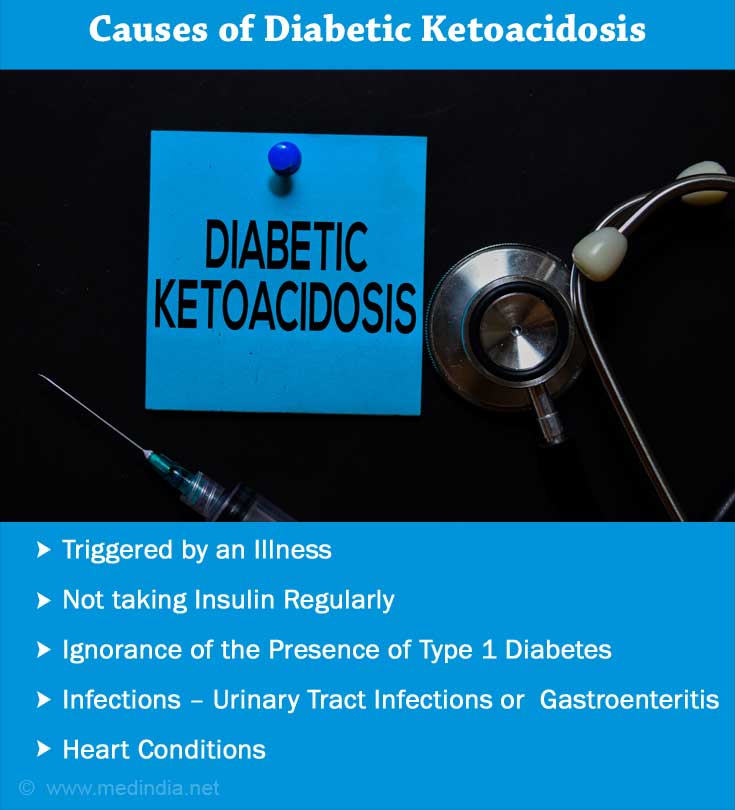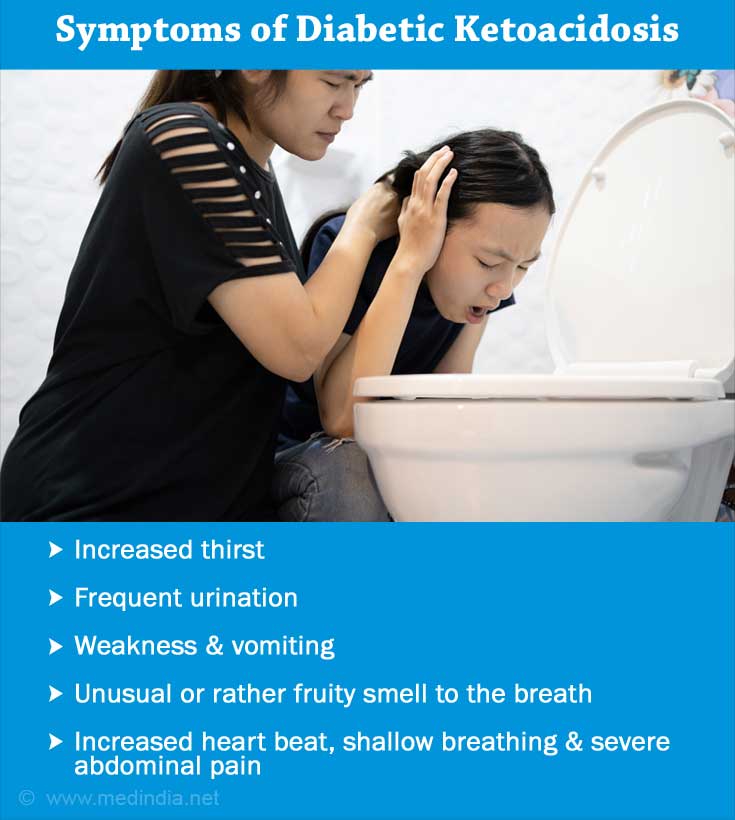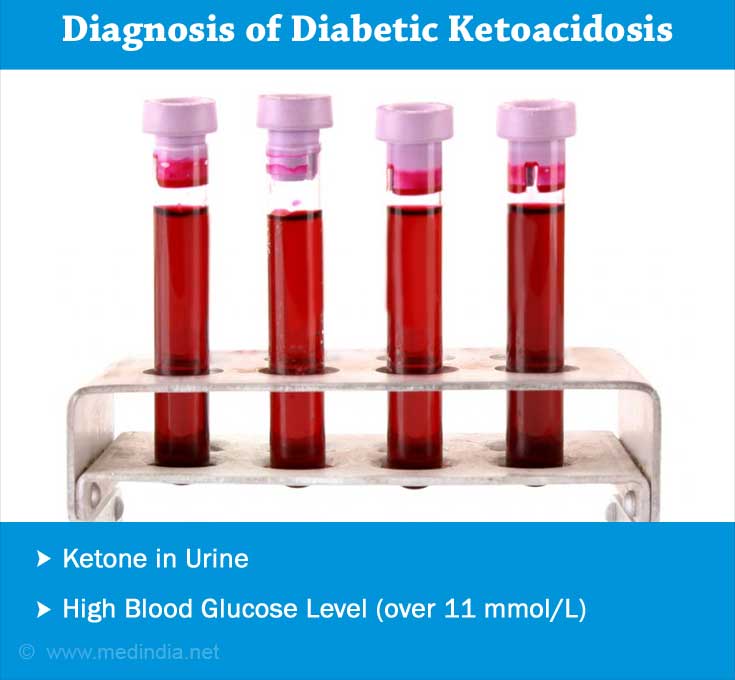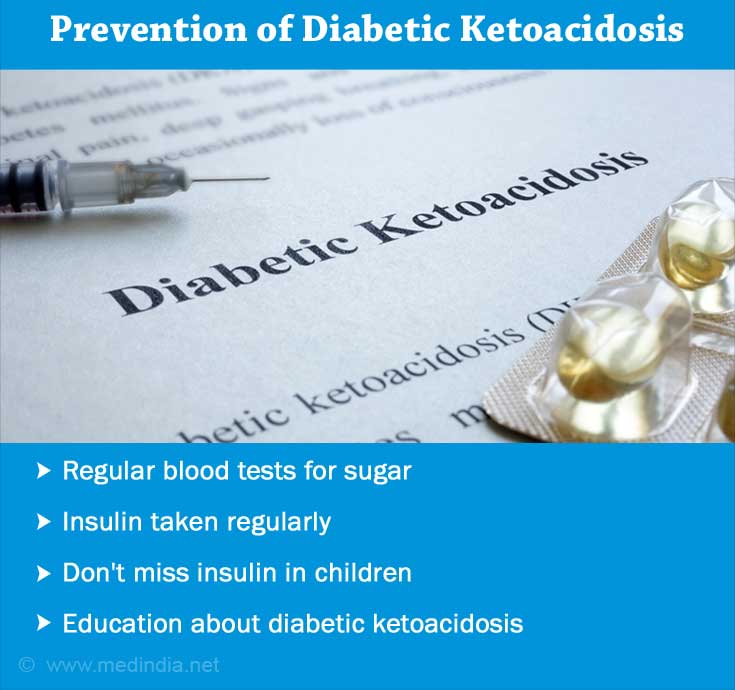- What is Diabetic Ketoacidosis? - (https://www.diabetes.org.uk/Guide-to-diabetes/Complications/Diabetic_Ketoacidosis/)
- Diabetic Ketoacidosis - (http://www.endoemergencies.org/sample-chapter.html)
What is Diabetic Ketoacidosis (DKA)?
Diabetic ketoacidosis (DKA) is a complication of uncontrolled diabetes characterized by the presence of a lower than normal pH of the blood and ketones in the blood and urine.
Our body cells obtain their energy from glucose, which enters the cells with the help of insulin Type 1 diabetes occurs when the pancreas does not produce enough insulin, and is common at a young age. On the other hand, type 2 diabetes occurs due to a resistance of the body cells to the effects of insulin.
In a patient with diabetes, especially type 1 diabetes, if the body does not have enough insulin, the body cells use fat instead of glucose. The burning up of the fat results in the release of ketones. The ketones make the blood acidic, resulting in a condition called metabolic acidosis or diabetic ketoacidosis. The presence of ketones in the body gives a fruity odor to the breath which serves as a warning sign of the condition. Excess ketones are excreted in the urine.
In any diabetic patient with crampy abdominal pain which is of sudden onset along with vomiting, blood sugar levels should be tested immediately and if high (>250 milligrams/deciliter), the patient should be further investigated for DKA.
What are the Causes of Diabetic Ketoacidosis (DKA)?
DKA is usually triggered by an illness or a problem with insulin therapy in diabetic patients. Causes of DKA include:
- Non-compliance with treatment by young insulin dependent diabetics, that is, the patients do not take insulin on a regular basis. DKA may also occur due to a problem in an insulin pump which is used to deliver continuous insulin
- Presence of type 1 diabetes in a person who does not know he suffers from diabetes and has therefore not been treated
- Underlying infections like urinary tract infection, gastroenteritis, flu or dental abscess in a patient with diabetes
- Ongoing cardiovascular conditions like heart attack and stroke

Other causes include:
- Any stressful condition like surgery, emotional stress
- Excessive alcohol consumption
- Illegal drug abuse
What are the Symptoms of Diabetic Ketoacidosis (DKA)?
Symptoms of DKA include:
- Increased thirst and urination. The excess urination results in signs of dehydration like dry skin and mucous membranes
- General feeling of weakness
- Vomiting
- Unusual or rather fruity smell to the breath
- Rapid heart beat
- Rapid shallow breathing
- Severe abdominal pain

What are the Complications of Diabetic Ketoacidosis (DKA)?
Diabetes ketoacidosis can cause life-threatening complications which include:
- Severe dehydration resulting in hypovolemic shock (severe blood or fluid loss)
- Low blood potassium levels which cause severe abdominal and limb cramps, and can affect the heart
- Acute kidney failure
- Cerebral edema (swelling of the brain) resulting in symptoms like confusion, headache, irritability, seizures and altered consciousness
- Acute respiratory distress syndrome due to fluid accumulation in the lungs
How do you Diagnose Diabetic Ketoacidosis (DKA)?
Diagnosis of DKA is made based on the clinical picture of the patient and the several investigations. Blood pressure should be monitored regularly to determine the stability of the patient and to decide the fluid replacement.
Ketone Testing in Urine: The presence of ketones is tested in the urine using dipstick test. When a dipstick, which is coated with a chemical, is dipped in the urine sample of the patient, a color change occurs which indicates the presence of ketones.
Blood tests
- Arterial Blood Gases: The arterial blood gases measurement carried out on a blood sample indicates a low pH of less than 7.3 and low levels of bicarbonate in patients with DKA. Depending on the results, the DKA can be classified as mild, moderate or severe.
- Mild DKA – pH- 7.25-7.30, bicarbonate – 15-18meq/l
- Moderate DKA –pH – 7.00-7.24, bicarbonate – 10- <15meq/l
- Severe DKA – pH - < 7.00, bicarbonate - < 10meq/l
- Blood Glucose Testing: Blood glucose can be tested at home with the help of a glucometer or in a laboratory. A home glucometer is a small instrument. A small drop of blood is put on a special strip provided with the glucometer and is inserted into the glucometer, which gives the reading. A patient with diabetes ketoacidosis usually has a high blood glucose level above 250 milligrams/deciliter, though it may be normal in some cases.
- Blood Ketones: The blood also shows a high level of ketones of more than 5 mEq/L.
- Blood Urea Nitrogen: Blood urea nitrogen (BUN) levels are measured to check for kidney function
- Blood Electrolyte Levels: The serum levels of electrolytes like potassium, calcium, sodium, phosphate and magnesium may vary and should be monitored during treatment. The levels may also fluctuate during treatment with insulin and therefore should be repeated frequently.

Tests to Detect Triggering Factor: Tests to find the cause of the ketoacidosis like ECG to check for heart condition, and blood and urine culture to test for infection should also be done.
How do you Treat Diabetic Ketoacidosis (DKA)?
DKA is a medical emergency which requires hospitalization. Treatment includes the following:
- Intravenous fluids are administered to correct the dehydration and normalize the pH and electrolyte levels. Normal saline is usually used initially which is later replaced by other solutions depending on the blood glucose control
- Intravenous insulin is administered to bring the blood glucose level to normal. Insulin is given with intravenous fluid or through an insulin pump.
- Potassium and magnesium are also added to intravenous fluids to replace the electrolytes.
- The underlying cause of diabetes ketoacidosis is treated.
- Complications like cerebral edema are also addressed.
How do you Prevent Diabetic Ketoacidosis (DKA)?
The following precautions may help to prevent diabetic ketoacidosis:
- Patients and families with type 1 diabetes should be educated about the importance of taking insulin injections regularly and in the prescribed dose
- They should also be taught to recognize symptoms and signs of diabetic ketoacidosis early so that treatment can be initiated in the early stage
- Any condition that can precipitate an attack like tooth pain and emotional stress should be immediately addressed. Blood glucose levels may need to be monitored more frequently in these situations
- Blood glucose level should be monitored on a regular basis as advised by the physician







